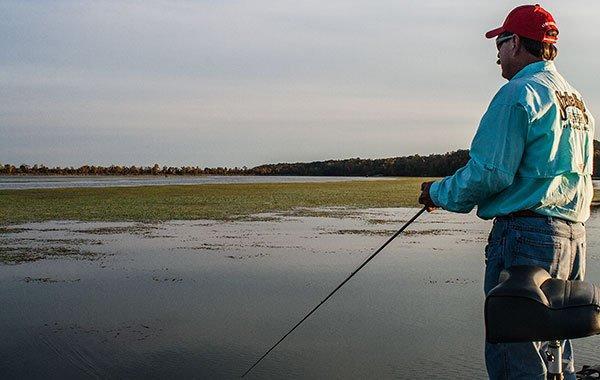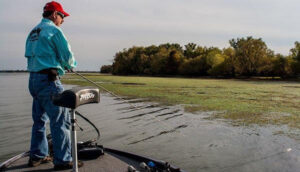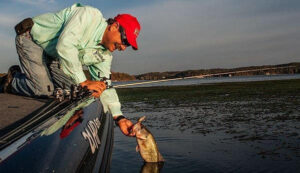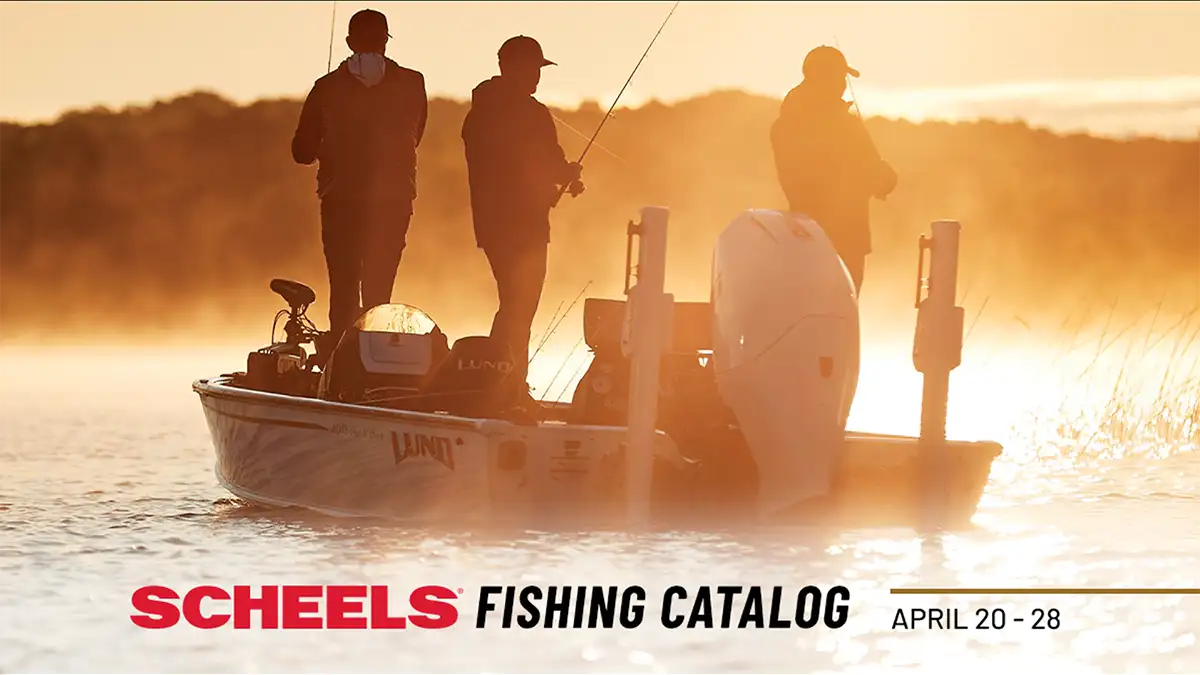You’ve been thinking about it all week. A single, solitary grass bed has engulfed your thoughts and inundated your mind throughout the workweek. You had to leave them biting last Sunday when it got dark. Instead of sleeping like the rest of your family, you remain awake, fervently flipping through fish picture after fish picture on your smart phone. Your eyes are bloodshot, your breathing is labored and you’re beginning to get the cold sweats. Surely it won’t hurt if you call in sick for just one day, right?
You inspect the thenar space between your thumb and index finger—it’s beginning to heal from last weekend’s slugfest on your home lake. You need a fix—something, anything—to get you to the weekend. Does it still smell like bass? Looking over your shoulder to make sure no one is looking, you sniff—nothing. Yeah, that’s right. You just smelled your hand in hopes of acquiring one last trace of the sweet smell of success. It’s okay. Don’t be embarrassed, and it’s totally okay to cry. It happens to me, too. You, my friend, have a case of fall frogitis.
If the mere thought of frog fishing doesn’t get your blood pumping and your heart palpitating, you may need to check your pulse. Catching big bass on a big worm, crankbait or jig is always fun, but nothing showcases the innate predatory instincts and ferocity of bass quite like frog fishing.
Terry and I recently had the opportunity to do a little frog fishing with FIRST pro Shaw Grigsby, and we were given great insight into some awesome frogging tips. Cutting his teeth on numerous Florida grass fisheries early in his career, Grigsby has developed some very unique techniques that will help you catch more fish and remedy your craving for the acrobatic, ferocious strikes that we all know and love.
A common misconception
When many anglers think about frog fishing, images of matted grass flood their minds. While the frog is, indeed, ideal for these types of areas, it is important to consider the unmatched versatility of a frog. Regardless of the water conditions or available cover, Grigsby never hesitates to throw his Strike King KVD Sexy Frog.
“I’ve had a lot of success throwing the Sexy Frog in places where most guys would tend to throw a Sexy Dawg,” Grigsby said. “You don’t need to have particular conditions for it to work. I’ll toss it around rocky points, under docks and even in clear, deep water.”
Differentiating your bait selection and presentation is essential to getting the most out of your fishing day. Because very few anglers take the time to throw a frog in areas free of grass, the residing bass are largely uneducated to the unique profile and action of the Sexy Frog. Any time you can present the bass with something they may not see very often, you have a substantial advantage over other anglers.
“Big bass get used to seeing the same old thing being thrown their way,” Grigsby said. “If you take a frog and throw it around some of the more inconspicuous areas of your fishery, you might surprise yourself and catch some really awesome fish.”
Customization
Perhaps one of the most advantageous traits of frogs is their ability to be tweaked and customized for several different situations. Sometimes a small, seemingly insignificant modification can make all of the difference in the world. Grigsby categorizes his Sexy Frogs into two separate groups—slop frogs and open water frogs.
“As the name suggests, I use my slop frogs in the nastiest, thickest stuff I can find,” Grigsby said. “I like to barely bend the hooks away from the body of the bait to help get a good hook in the fish, but I still want the hook points barely touching the frog to help me avoid hang-ups.”
With his open water frogs, Grigsby tends to get a little more creative when it comes to customization. Due to the absence of gnarly, snag-inducing cover, he bends the hooks upwards and away from the body of the frog to ensure a solid hookset. If the bass are keying in on a wide, erratic retrieve, he reaches for his scissors.
“The Sexy Frog is sweet bait and will walk right out of the package,” Grigsby said. “But if I’m looking for a really wide-walking presentation, I’ll trim about an inch off of just one leg of the frog and the bass will absolutely crush it!”
While trimming one leg of the frog works well, trimming both legs can, at times, be even better. When faced with stubborn bass and tough fishing conditions, Grigsby believes that the bass often prefer a smaller, more compact profile. For this reason, he will trim two inches from both legs, creating a less threatening presentation that will draw some really exciting strikes.
Finding the mother load
Whether we like to admit it or not, many of us have simply stumbled upon fish in areas that don’t make a bit of sense. While situations like that are a lot of fun, knowing the right things to look for can lead to more consistent success.
“Anytime I’m fishing cover with frogs, I’m always looking for a reason for them to be there,” Grigsby said. “Two of my favorite things to find are ditches and points. I idle around a lot, looking at my Lowrance to find ditches that allow big bass to easily migrate to and from deeper water. Grass points are great, too, because fish love to relate to irregularities in the grass.”
Holes in matted grass are also a big favorite for Grigsby. Although big areas of matted grass look like thick and uninhabitable labyrinths to us, bass use the underside of these mats as highways, constantly moving around and searching for the perfect ambush spot to attack unsuspecting prey. These holes create perfect feeding opportunities for big bass.
“Big bass love to sit on the edges of these holes, just waiting for the perfect opportunity to strike,” Grigsby said. “When you swim a Sexy Frog across these openings, bass can’t help themselves and will absolutely annihilate it.”
Retrieve styles
A common mistake among many bass anglers, including myself, is working a frog the same way in every situation. Depending upon the mood of the bass, Grigsby drastically changes his retrieve to get more bites.
“When the fish are really active, I will try to make my frog sound almost like a buzzbait,” Grigsby said. “I know it sounds crazy, but if you pop the Sexy Frog as fast as you can, it makes the same ‘clacking’ noise that a buzzbait emits. Using this retrieve, I can catch a lot of pressured fish that may be wise to a buzzbait or the normal cadence of a frog, but have never seen a combination of the two.”
When making long casts to the edges of grass lines, Grigsby prefers a walking retrieve, giving the Sexy Frog the action of a hard, walking topwater bait like the Sexy Dawg. To achieve the most realistic retrieve, it is important to understand that you should never move the frog with your reel—only the sharp, downward twitches of the rod should move the bait, with the reel being used solely for retrieving slack line.
Importance of a good hookset and rod
There are many techniques in bass fishing that will allow anglers the chance to “get away” with using subpar equipment, but frog fishing is not one of them. With two huge hooks to drive into the mouth of a big bass, a good hookset and proper equipment is essential.
“A lot of people like to feel the fish before they set the hook with a frog, but I never do that,” Grigsby said. “If the fish is swimming towards you, you’ll never feel it. I generally give the fish half of a second after the blowup, and then I’ll really lay into them. The Sexy Frog has two beastly hooks on it and penetrating those hooks at the same time takes a huge hookset. For this reason, you always need to have your rod tip down when you work a frog, which minimizes your slack and puts you in a good position for a powerful, upwards hookset.”
To aid his monstrous hooksets, Grigsby uses a 7-foot, medium-heavy Quantum Tour Elite Dean Rojas Frog Rod. The rod’s fast tip allows him to cast like a rocket, while its backbone packs a huge punch.
“I come off my feet when I set the hook on a frog fish, and this rod gives me all of the power I could ever want,” Grigsby said. “A fast tip is necessary when I’m trying to skip the frog into thick cover, while it also helps me work the frog just the way I want to.”
Fall frog fishing is a great way to catch a lot of big fish, but it can certainly take some time to master. If you take the time to modify your frog correctly, find the right areas, experiment with different retrieves and get your hands on the right equipment, you’ll have a great time trying to curb your case of fall frogitis.














